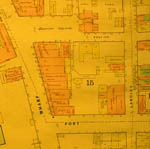By examining the experience of the Aboriginal
peoples within colonial Victorian society, the larger context of nineteenth
century racism and imperialism can be identified. The racial composition
of Victoria was diverse in the Victorian era and racism and imperialism
in the social structure of Victoria was a dominating force. During
this period the existing sentiment to maintain a purely white majority
was prominent.
The construction of racial identities and acknowledgement of difference
in colonial British Columbia contributed to the creation of meticulously
structured system of hierarchical categorizations that determined
the social worth of different groups. A socially accepted creation
or imagining of everything from ethnicity to culture, created categorizations
based on race.
During the period of initial contact, the fur-trader relationship
with the Aboriginals is believed to be based on a mutual understanding
and a delicate balance of respect together with indignation. Following
the fur-trade years, there appears to have been a shift in the perception
(and the usefulness) of the natives to the European settlers. Increasingly,
the local native population became more dependent on Europeans. This
dependency can be attributed to the destruction of their traditional
gathering economy in order to accommodate the emerging and aggressive
European ideals.
The Indians were now to be treated as the children of the Europeans,
and were to be both ‘re-designed’ and educated to reflect
the British image. As the ‘children’ of the whites, the
Aboriginals were subject to the rules and dictating nature of the
European form of governance and law. They were discriminated against
socially, economically, and politically, and were increasingly implicated
in petty crimes. The criminal and disorderly activities of the Indians
often included the thefts of livestock, and the subsequent police
patrolling the Indian settlement took a considerable toll on the resources
of the police force.
The disparity between legal implications of Indian actions, and
their perception of European law, encouraged further separation of
the two races. The creation of additional distinctions borne from
gross misunderstandings between the two cultures further encouraged
hostility. “The act of denigrating another, permits people to
close ranks with each other; the identification of an external threat,
whether real or imagined, restores fraternity.”
---------------------------------------------------------------------------------------------------------------------
Documents
 Songhees
Reserve and Victoria Harbour, 1860s.
Songhees
Reserve and Victoria Harbour, 1860s.
BCA Call Number: F-09568
---------------------------------------------------------------------------------------------------------------------








